2017年6月英语六级真题(第二套)
Part IWriting(30 minutes)
Directions: Supposeyouareaskedtogiveadviceonwhethertoattendcollegeathomeorabroad,
write an essay tostate your opinion. You are required towrite at least 150 words
but no more than 200words.
Part II
Section A
Listening Comprehension
(30 minutes)
Directions: Inthissection,youwillheartwolongconversations.Attheendofeachconversation,
youwillhearfourquestions.Boththeconversationandthequestionswillbespoken
only once. After you hear a question, you must choose the best answer from the four
choicesmarkedA),B),C)andD). ThenmarkthecorrespondingletteronAnswerSheet
I with a single line through the centre.
Questions 1 to 4 are based on the conversation you have just heard.
1. A)He would feel insulted.
B)He would feel very sad.
C)He would be embarrassed.
D)He would be disappointed.
2. A)They are worthy of a prize.
B)They are of little value.
C)They make good reading.
D)They need improvement.
3. A)He seldom writes a book straight through.
B)He writes several books simultaneously.
C)He draws on his real-life experiences.
D)He often turns to his wife for help.
4. A)Writing a book is just like watching a football match.
B)Writers actually work every bit as hard as footballers.
C)He likes watching a football match after finishing a book.
D)Unlike a football match, there is no end to writing a book.
Questions 5 to 8 are based on the conversation you have just heard.
5. A)Achievements of black male athletes in college.
B)Financial assistance to black athletes in college.
C)High college dropout rates among black athletes.
�
D)Undergraduate enrollments of black athletes.
6. A)They display great talent in every kind of game.
B)They are better at sports than at academic work.
C)They have difficulty finding money to complete their studies.
D)They make money for the college but often fail to earn a degree.
7. A)About 15%.
B)Around 40%.
C)Slightly over 50%.
D)Approximately 70%.
8. A)Coaches lack the incentive to graduate them.
B)College degrees do not count much to them.
C)They have little interest in academic work.
D)Schools do not deem it a serious problem.
Section B
Directions: In this section, you will hear two passages. At the end of each passage, you will
hearthreeorfourquestions.Boththepassageandthequestionswillbespokenonly
once.Afteryouhearaquestion,youmustchoosethebestanswerfromthefourchoices
marked A), B), C) and D). Then mark the correspondingletteronAnswerSheet1with
a single line through the centre.
Questions 9 to 12 are based on the passage you have just heard.
9. A)Marketing strategies.
B)Holiday shopping.
C)Shopping malls.
D)Online stores.
10. A)About 50% of holiday shoppers.
B)About 20%–30% of holiday shoppers.
C)About 136 million.
D)About 183.8 million.
11. A)They have fewer customers.
B)They find it hard to survive.
C)They are thriving once more.
D)They appeal to elderly customers.
12. A)Better quality of consumer goods.
B)Higher employment and wages.
C)Greater varieties of commodities.
D)People having more leisure time.
�
Questions 13 to 15 are based on the passage you have just heard.
13. A)They are new species of big insects.
B)They are overprescribed antibiotics.
C)They are life-threatening diseases.
D)They are antibiotic-resistant bacteria.
14. A)Antibiotics are now in short supply.
B)Many infections are no longer curable.
C)Large amounts of tax money are wasted.
D)Routine operations have become complex.
15. A)Facilities.
B)Expertise.
C)Money.
D)Publicity.
Section C
Directions: In this section, you will hear three recordings of lectures or talks followed by
three or four questions. The recordings will be played only once. After you hear a
question,youmustchoosethebestanswerfromthefourchoicesmarkedA),B),C),
andD).ThenmarkthecorrespondingletteronAnswerSheet1withasinglelinethrough
the centre.
Questions 16 to 18 are based on the recording you have just heard.
16. A)It is accessible only to the talented.
B)It improves students’ ability to think.
C)It starts a lifelong learning process.
D)It gives birth to many eminent scholars.
17. A)They encourage academic democracy.
B)They promote globalization.
C)They uphold the presidents’ authority.
D)They protect students’ rights.
18. A)His thirst for knowledge.
B)His eagerness to find a job.
C)His contempt for authority.
D)His potential for leadership.
Questions 19 to 22 are based on the recording you have just heard.
19. A)Few people know how to retrieve information properly.
�
B)People can enhance their memory with a few tricks.
C)Most people have a rather poor long-term memory.
D)People tend to underestimate their mental powers.
20. A)They present the states in a surprisingly different order.
B)They include more or less the same number of states.
C)They are exactly the same as is shown in the atlas.
D)They contain names of the most familiar states.
21. A)Focusing on what is likely to be tested.
B)Having a good sleep the night before.
C)Reviewing your lessons where the exam is to take place.
D)Making sensible decisions while choosing your answers.
22. A)Discover when you can learn best.
B)Change your time of study daily.
C)Give yourself a double bonus afterwards.
D)Follow the example of a marathon runner.
Questions 23 to 25 are based on the recording you have just heard.
23. A)He is a politician.
B)He is a businessman.
C)He is a sociologist.
D)He is an economist.
24. A)In slums.
B)In Africa.
C)In pre-industrial societies.
D)In developing countries.
25. A)They have no access to health care, let alone entertainment or recreation.
B)Their income is less than 50% of the national average family income.
C)They work extra hours to have their basic needs met.
D)Their children cannot afford to go to private schools.
Part
III
Section A
Reading Comprehension
(40 minutes)
Directions: Inthissection,thereisapassagewithtenblanks.Youarerequiredtoselectone
wordforeachblankfromalistofchoicesgiveninawordbankfollowingthepassage.
Readthepassagethroughcarefullybeforemakingyourchoices.Eachchoiceinthebank
isidentifiedbyaletter.PleasemarkthecorrespondingletterforeachitemonAnswer
Sheet 2 with a single line through the centre. You may not use any of the words in
the bank more than once.
�
After becoming president of Purdue University in 2013, Mitch Daniels asked the faculty to
prove that their students have actually achieved one of higher education’s most important goals:
critical thinking skills. Two years before, a nationwide study of college graduates had shown
that more than a third had made no
26
gains in such mental abilities during their school
years. Mr. Daniels, needed to
27
the high cost of attending Purdue to its students and
their families. After all, the percentage of Americans who say a college degree is “very
important” has fallen
28
in the last 5-6 years.
Purdue now has a pilot test to assess the critical thinking skills of students as they progress.
Yet like many college teachers around the United States, the faculty remain
29
that their
work as educators can be measured by a “learning
30
such as a graduate’s ability to
investigate and reason”. However the professors can use
31
metrics to measure how well
students do in three key areas: critical thinking, written communication, and quantitative literacy.
Despite the success of the experiment, the actual results are worrisome, and mostly
32
earlier studies. The organizers of the experiment concluded that far fewer students were
“achieving at high levels on a critical thinking than they were doing for written communication
or quantitative literacy”. And that conclusion is based only on students nearing graduation.
American universities, despite their global
33
for excellence in teaching, have only
begun to demonstrate what they can produce in real-world learning. Knowledge-based degrees
are still important. But employers are
34
advanced thinking skills from college
graduate. If the intellectual worth of a college degree can be
35
measured, more people
will seek higher education—and come out better thinkers.
A)accurately
B)confirm
C)demanding
D)doubtful
E)drastically
F)justify
G)monopolized
H)outcome
Section B
I)predominance
J)presuming
K)reputation
L)significant
M)signify
N)simultaneously
O)standardized
Directions: In this section, you are going to read a passage with ten statements attached to
it.Eachstatementcontainsinformationgiveninoneoftheparagraphs.Identifythe
paragraphfromwhichtheinformationisderived.Youmaychooseaparagraphmorethan
once. Each paragraph is marked with a letter. Answer the questions by marking the
corresponding letter on Answer Sheet 2.
�
Elite Math Competitions Struggle to Diversify Their Talent Pool
[A] Interest in elite high school math competitions has grown in recent years, and in light of
last summer’s U.S. win at the International Math Olympiad—the first for an American team in
more than two decades—the trend is likely to continue.
[B] But will such contests, which are overwhelmingly dominated by Asian and white students from
middle-class and affluent families, become any more diverse? Many social and cultural factors
play roles in determining which promising students get on the path toward international math
recognition. But efforts are in place to expose more black, Hispanic, and low-income students
to advanced math, in the hope that the demographic pool of high-level contenders will eventually
begin to shift and become less insular.
[C] “The challenge is if certain types of people are doing something, it’s difficult for other
people to break into it,” said Po-Shen Loh, the head coach of last year’s winning U.S. Math
Olympiad team and an associate professor of mathematics at Carnegie Mellon University.
Participation grows through friends and networks and if “you realize that’s how they’re growing,
you can start to take action” and bring in other students, he said.
[D] Most of the training for advanced-math competitions happens outside the confines of the normal
school day. Students attend after-school clubs, summer camps, online forums and classes, and
university-based “math circles”, or mathematician-led groups, to prepare for the paper-based
and face-to-face competitions.
[E] One of the largest feeders for high school math competitions—including those that eventually
lead to the International Math Olympiad—is a middle school program called MATHCOUNTS. About
100,000 students around the country participate in the program’s competition series, which
culminates in a national game-show-style contest held each May. The most recent one took place
last week in Washington. Students join a team through their schools, which provide a volunteer
coach and pay a nominal fee to send students to regional and state competitions. The 224 students
who make it to the national competition get an all-expenses-paid trip.
[F] Nearly all members of last year’s winning U.S. IMO team took part in MATHCOUNTS as middle
school students—as did Loh, the coach. “Middle school is an important age because students
have enough math capability to solve advanced problems, but they haven’t really decided what
they want to do with their lives,” said Loh. “They often get hooked then.”
�
[G] Another influential feeder for advanced-math students is an online school called Art of
Problem Solving, which began about 13 years ago and now has 15,000 users. Students use forums
to chat, play games, and solve problems together at no cost, or they can pay a few hundred dollars
to take courses with trained teachers. According to Richard Rusczyk, the company founder, the
six U.S. team members who competed at the International Math Olympiad last year collectively
took more than 40 courses on the site. Parents of advanced-math students and MATHCOUNTS coaches
say the children are on the website constantly.
[H] There are also dozens of summer camps—many attached to universities—that aim to prepare
elite math students. Some are pricey—a three-week, intensive program can cost $4,500 or more—but
most offer scholarships. The Math Olympiad Summer Training Program—the three-week math camp
held by the Mathematical Association of America that leads straight to the international
championship—is free for those who make it. Only about 50 students are invited based on their
performance on written tests and at the USA Math Olympiad.
[I] Students in university towns may also have access to another lever for involvement in
accelerated math: math circles. In these groups, which came out of an Eastern European tradition
of developing young talent, professors teach promising K-12 students advanced mathematics for
several hours after school or on weekends. The Los Angeles Math Circle, held at the University
of California, Los Angeles, began in 2007 with 20 students and now has more than 250.
[J] According to Mark Saul, the director of competitions for the Mathematical Association of
America, not a single African-American or Hispanic student—and only a handful of girls—has
ever made it to the Math Olympiad team in its 50 years of existence. Many schools simply don’t
prioritize academic competitions. “Do you know who we have to beat?” asked Saul. “The football
team, the basketball team—that’s our competition for resources, student time, attention, school
dollars, parent efforts, school enthusiasm.”
[K] According to Lou DiGioia, the program’s executive director, those connections often last
well into high school, and beyond. “Kids at the MATHCOUNTS national competition are in the top
echelon of math intelligence—they’re just in their own world. It’s great for them to come
together and have a network of people.” There is a downside to the social aspect of advanced-math
competitions: It can breed insular communities.
[L] A New York City-based nonprofit called Bridge to Enter Mathematics runs a residential summer
program aimed at getting underserved, mostly black and Hispanic students working toward math
and science careers. The summer after 7th grade, students spend three weeks on a college campus
studying advanced math for seven hours a day. Over the next five years, the group helps the students
�
get into other elite summer math programs, high-performing high schools, and eventually college.
About 250 students so far have gone through the program, which receives funding from the Jack
Kent Cooke Foundation. (The foundation also supports some coverage of low-income, high-achieving
students in Education Week.)
[M] “If you look at a lot of low-income communities in the United States, there are programs
that are serving them, but they’re primarily centered around, ‘Let’s get these kids’ grades
up,’ and not around, ‘Let’s get these kids access to the same kinds of opportunities as
more-affluent kids,’ ” said Daniel Zaharopol, the founder and executive director of the program.
“We’re trying to create that pathway.” Students apply to the program directly through their
schools. “We want to reach parents who are not plugged into the system,” said Zaharopol.
36. Middle school is a crucial period when students may become keenly interested in advanced
mathematics.
37. Elite high school math competitions are attracting more interest throughout the United States.
38. Math circles provide students with access to advanced-math training by university professors.
39. Students may take advantage of online resources to learn to solve math problems.
40. The summer program run by a nonprofit organization has helped many underserved students learn
advanced math.
41. Winners of local contests will participate in the national math competition for free.
42. Many schools don’t place academic competitions at the top of their priority list.
43. Contestants of elite high school math competitions are mostly Asian and white students from
well-off families.
44. Some math training programs primarily focus on raising students’ math score.
45. Some intensive summer programs are very expensive but most of them provide scholarships.
Section C
Directions: There are 2 passages in this section. Each passage is followed by some questions
or unfinished statements. Foreach of them there are four choices marked A), B),C)
andD). YoushoulddecideonthebestchoiceandmarkthecorrespondingletteronAnswer
Sheet 2 with a single line through the centre.
Passage One
Questions 46 to 50 are based on the following passage.
We live today in indebted to McCardell, Cashin, Hawes, Wilkins, and Maxwell, and other women
who liberated American fashion from the confines of Parisian design. Independence came in trying,
wrapping, storing, harmonizing, and rationalizing that wardrobe. These designers established the
modern dress code, letting playsuits and other activewear outfits suffice for casual closing,
�
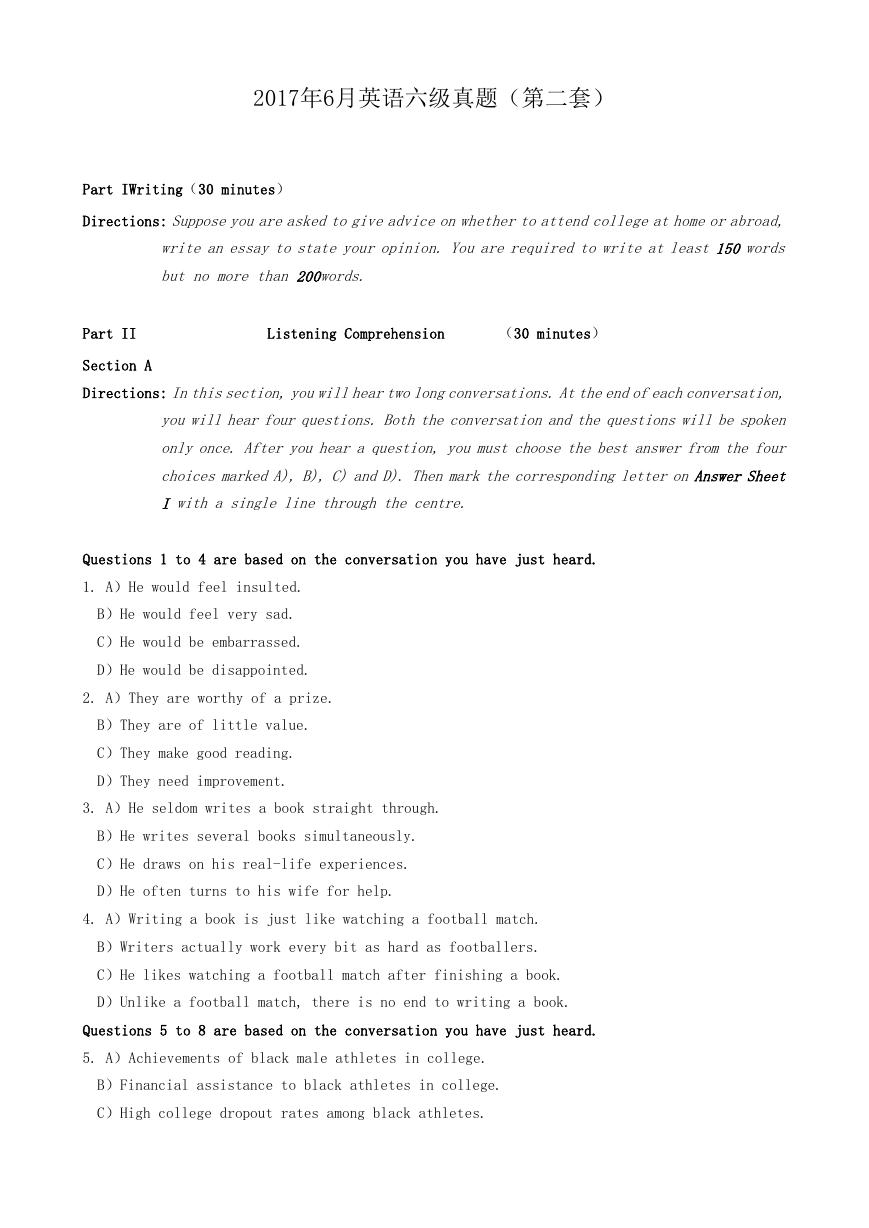
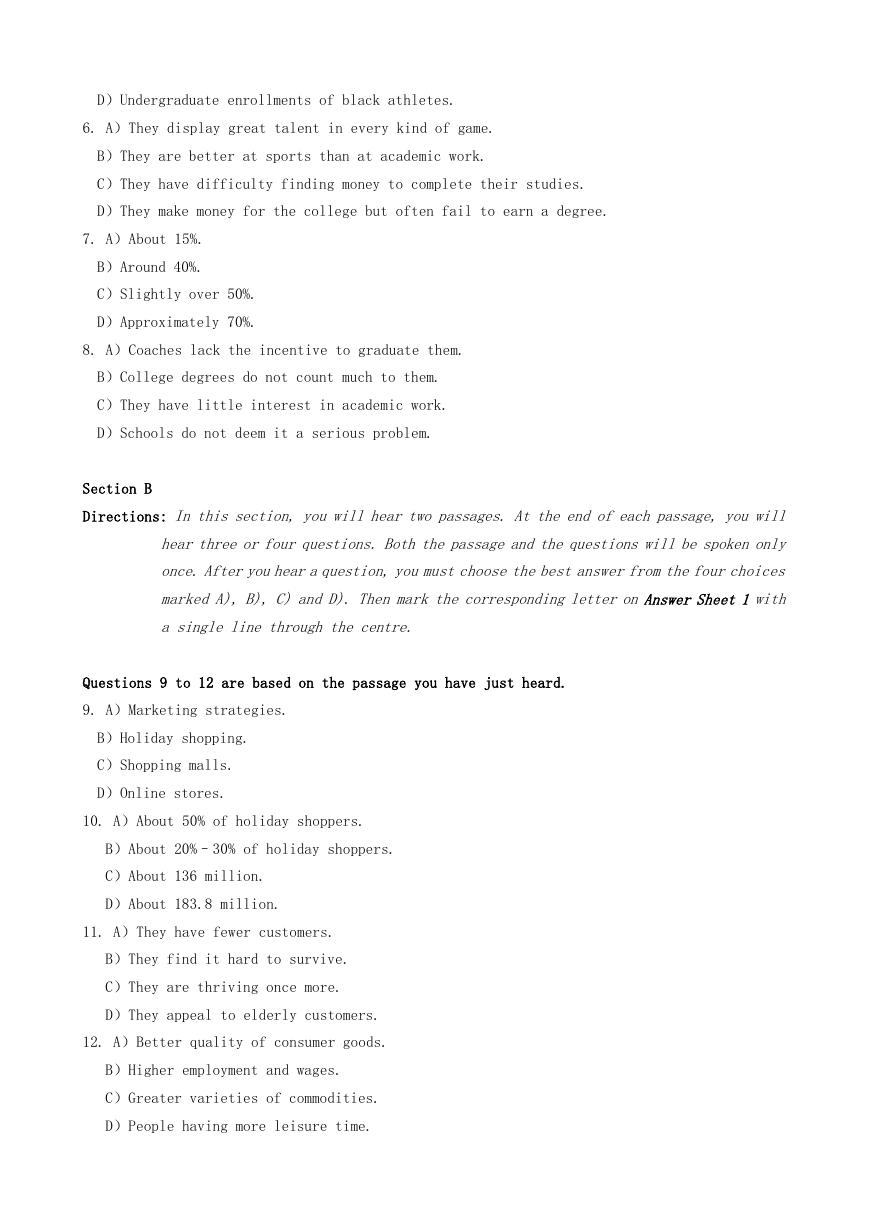
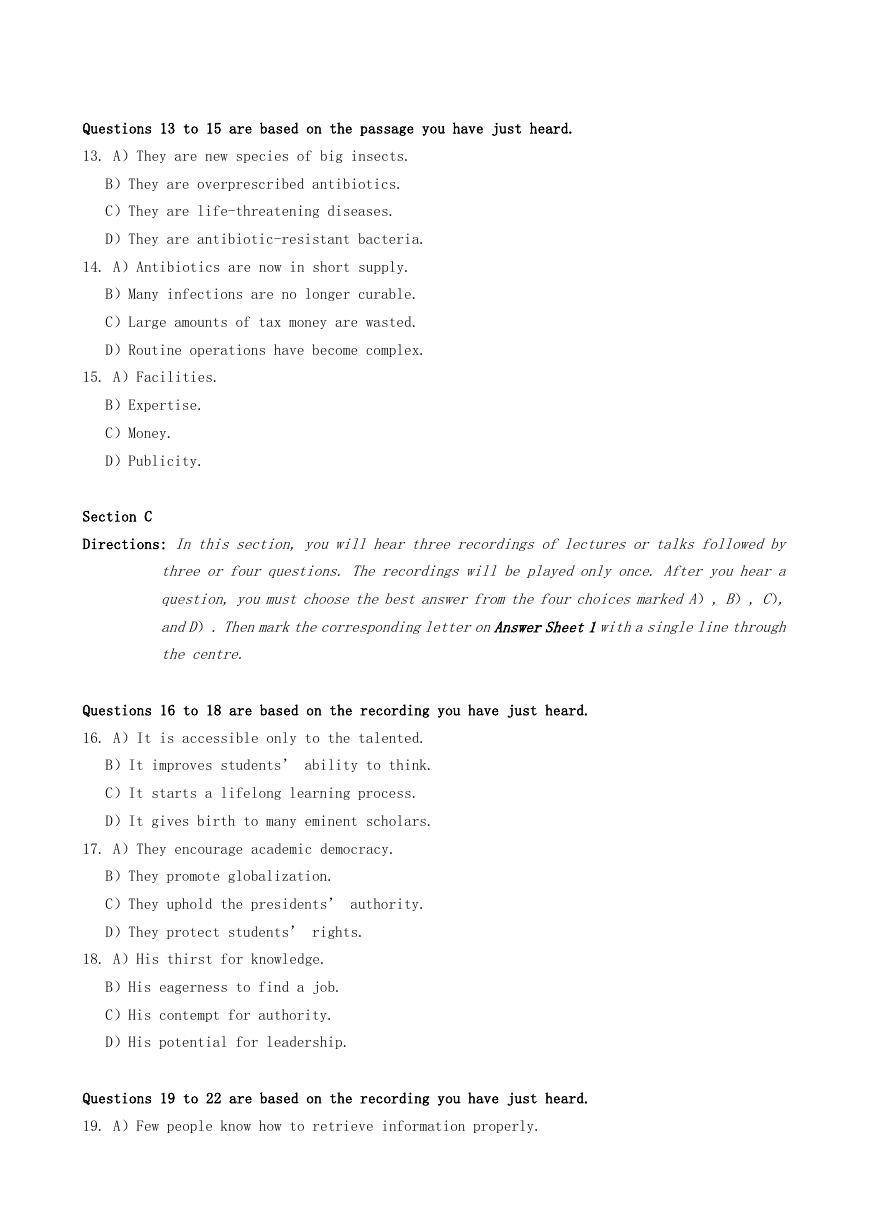
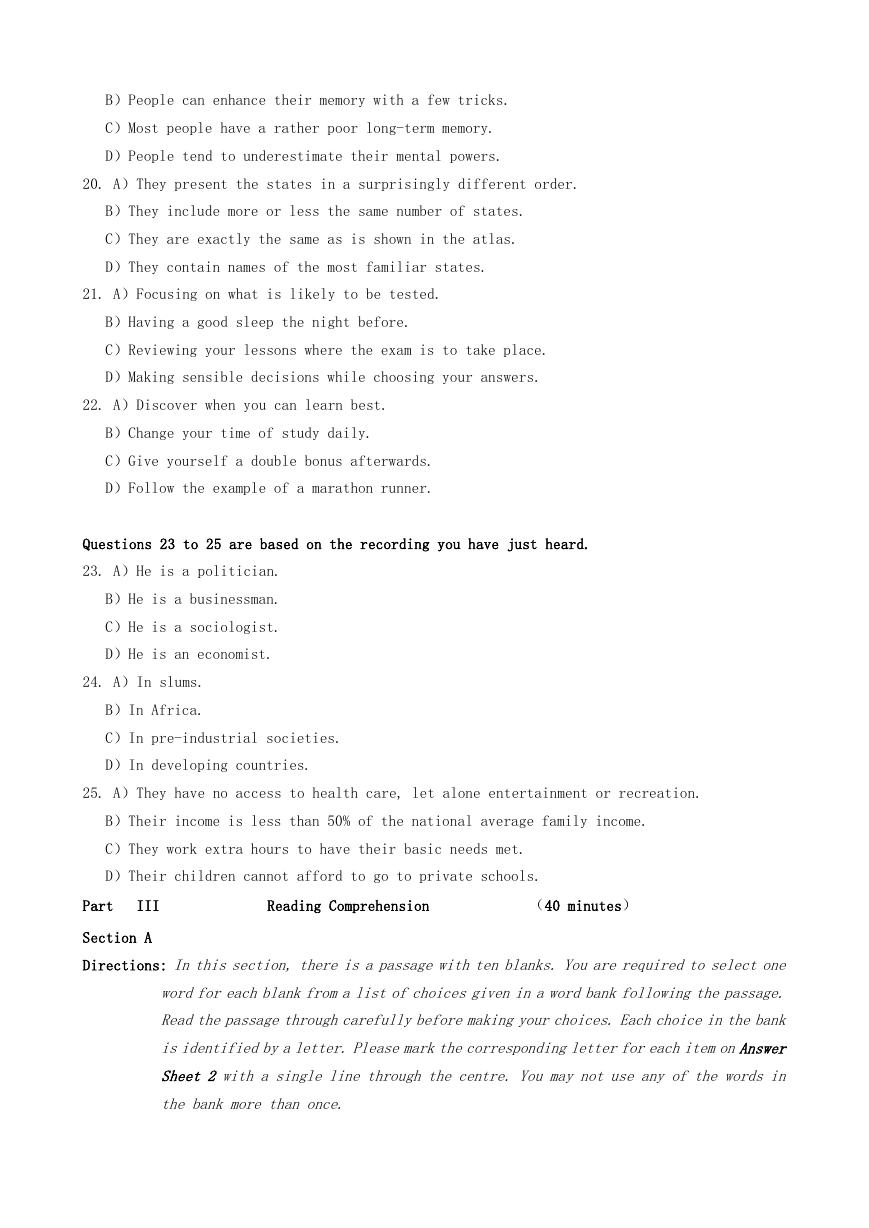

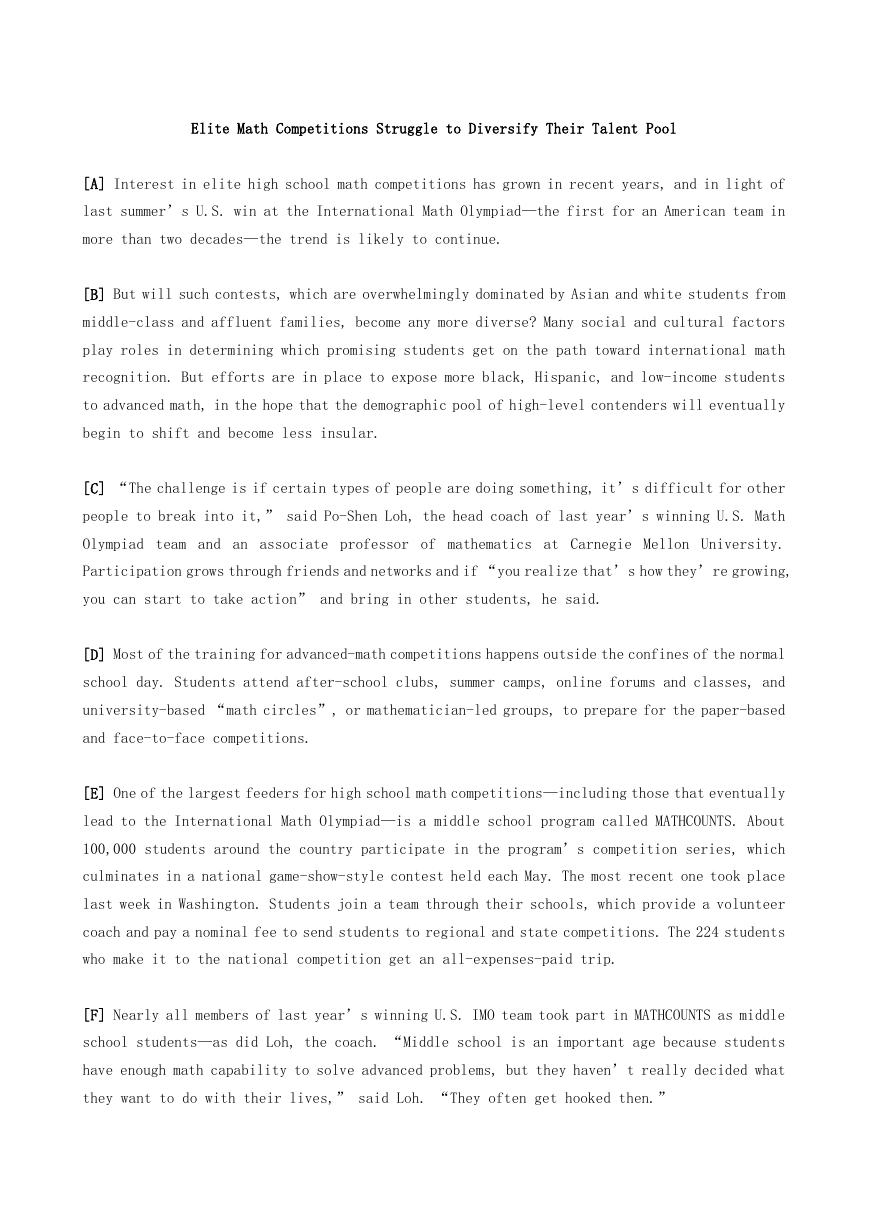

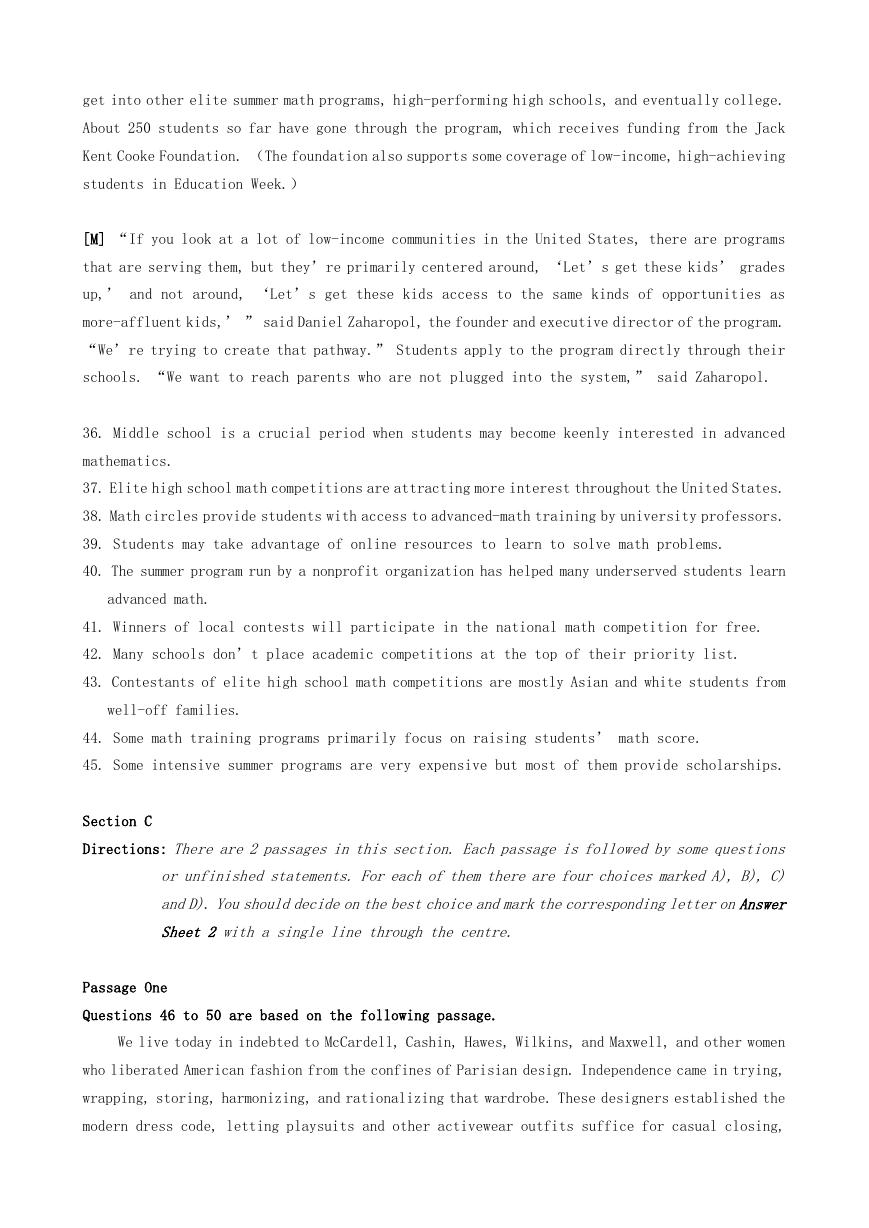








 2023年江西萍乡中考道德与法治真题及答案.doc
2023年江西萍乡中考道德与法治真题及答案.doc 2012年重庆南川中考生物真题及答案.doc
2012年重庆南川中考生物真题及答案.doc 2013年江西师范大学地理学综合及文艺理论基础考研真题.doc
2013年江西师范大学地理学综合及文艺理论基础考研真题.doc 2020年四川甘孜小升初语文真题及答案I卷.doc
2020年四川甘孜小升初语文真题及答案I卷.doc 2020年注册岩土工程师专业基础考试真题及答案.doc
2020年注册岩土工程师专业基础考试真题及答案.doc 2023-2024学年福建省厦门市九年级上学期数学月考试题及答案.doc
2023-2024学年福建省厦门市九年级上学期数学月考试题及答案.doc 2021-2022学年辽宁省沈阳市大东区九年级上学期语文期末试题及答案.doc
2021-2022学年辽宁省沈阳市大东区九年级上学期语文期末试题及答案.doc 2022-2023学年北京东城区初三第一学期物理期末试卷及答案.doc
2022-2023学年北京东城区初三第一学期物理期末试卷及答案.doc 2018上半年江西教师资格初中地理学科知识与教学能力真题及答案.doc
2018上半年江西教师资格初中地理学科知识与教学能力真题及答案.doc 2012年河北国家公务员申论考试真题及答案-省级.doc
2012年河北国家公务员申论考试真题及答案-省级.doc 2020-2021学年江苏省扬州市江都区邵樊片九年级上学期数学第一次质量检测试题及答案.doc
2020-2021学年江苏省扬州市江都区邵樊片九年级上学期数学第一次质量检测试题及答案.doc 2022下半年黑龙江教师资格证中学综合素质真题及答案.doc
2022下半年黑龙江教师资格证中学综合素质真题及答案.doc